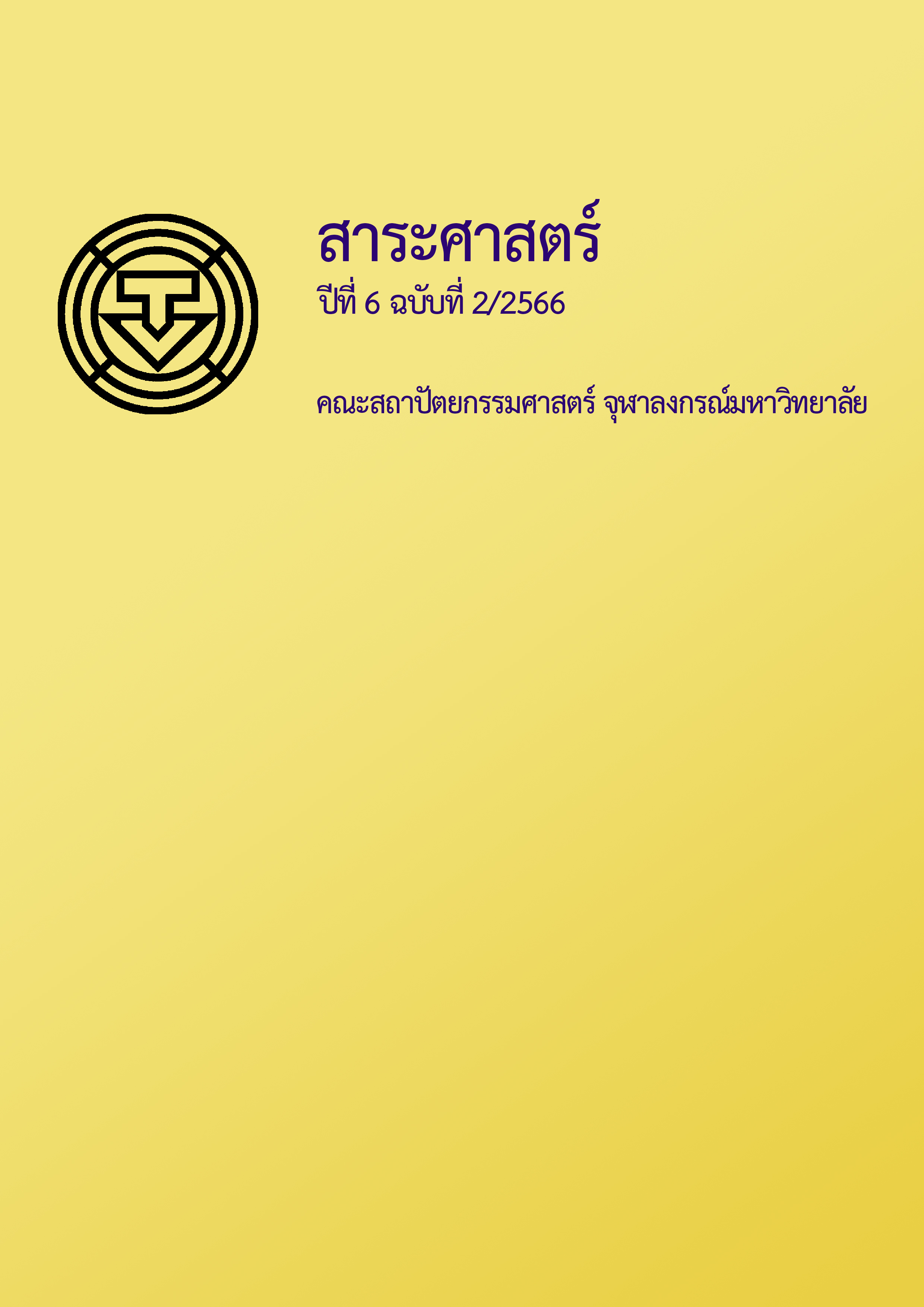การนำวัสดุก่อสร้างมือสองจากมูลนิธิสวนแก้วไปประยุกต์ใช้ในการก่อสร้าง ที่อยู่อาศัยของผู้มีรายได้น้อย
Main Article Content
บทคัดย่อ
ในทฤษฎีลำดับขั้นความต้องการของ Maslow (Maslow’s Hierarchy of Needs) ระบุว่ามนุษย์จะถูกกระตุ้นให้เติมเต็มความต้องการขั้นพื้นฐานก่อน ถึงจะพัฒนาความต้องการอื่นเพิ่มขึ้นตามศักยภาพของตน เมื่อนำทฤษฎีดังกล่าวมาพิจารณาในด้านการอยู่อาศัย พบว่า ที่อยู่อาศัยของผู้มีรายได้น้อยส่วนใหญ่ยังคงอยู่ในขั้นที่หนึ่ง คือเพียงแค่อาศัยหลับนอนได้ แต่เมื่อผู้มีรายได้น้อยบางกลุ่ม มีความพร้อมและมีความสามารถในการจ่ายเพิ่มขึ้น ก็ส่งผลให้มีความต้องการด้านความมั่นคงและปลอดภัยที่เพิ่มมากขึ้น แต่ด้วยข้อจำกัดด้านเงินทุน จึงทำให้ผู้มีรายได้น้อยเหล่านี้ มองหาทางเลือกในการใช้วัสดุก่อสร้างที่แตกต่างออกไป ผู้วิจัยจึงสนใจศึกษาแหล่งทางเลือกในการนำวัสดุก่อสร้างมาพัฒนาที่อยู่อาศัย โดยคำนึงถึงความสามารถในการจ่ายของผู้มีรายได้น้อย จากการศึกษาพบว่าทางเลือกในการจัดหาวัสดุก่อสร้างราคาถูกมีด้วยกันหลายช่องทาง โดยหนึ่งในนั้นคือ การใช้วัสดุมือสองจาก “มูลนิธิสวนแก้ว” ที่ได้นำวัสดุที่ได้รับจากการบริจาค มาจำหน่ายให้ในราคาที่ถูกเพื่อให้ผู้มีรายได้น้อย สามารถสร้างที่อยู่อาศัยให้มั่นคงแข็งแรงเพิ่มมากขึ้น โดยผู้วิจัยได้ติดตามการนำวัสดุมือสองไปใช้ในการก่อสร้างและปรับปรุงบ้านจำนวน 12 หลัง พบว่ามีการก่อสร้าง 2 รูปแบบ คือการก่อสร้างด้วยตนเอง และก่อสร้างโดยการจ้างเหมา โดยผู้วิจัยได้เก็บข้อมูลจากการสำรวจ และการสัมภาษณ์ผู้อยู่อาศัย และผู้ก่อสร้างบ้าน เพื่อให้เห็นวิธีการนำวัสดุก่อสร้างมือสองมาใช้ รวมถึงปัญหาและวิธีการแก้ปัญหาที่เกิดขึ้น
ผลการศึกษา พบว่ามูลนิธิสวนแก้ว แบ่งวัสดุเป็น 5 ประเภท คือ ไม้ กระเบื้อง ประตูหน้าต่าง สุขภัณฑ์ และเบ็ดเตล็ด และจากการศึกษาบ้านทั้ง 12 หลัง พบว่าวัสดุมือสองนำไปประยุกต์ใช้ในการก่อสร้างเป็น 2 ประเภท คือ บ้านที่ใช้วัสดุตรงตามประเภทการใช้งาน และบ้านที่ใช้วัสดุไม่ตรงตามประเภทการใช้งาน พบปัญหาที่เกิดจากการก่อสร้างและการใช้งานที่แตกต่างกัน เช่น บ้านที่ใช้วัสดุของเก่ามีปัญหาเรื่องความแข็งแรงของวัสดุ ส่วนบ้านที่ใช้วัสดุก่อสร้างมือสองมีปัญหาเรื่องเวลาที่เพิ่มขึ้นจากการเตรียมวัสดุก่อนนำมาใช้งาน รวมถึงวิธีแก้ปัญหาที่แตกต่างกัน เช่น บ้านบางหลังที่หลังคารั่วจะใช้ป้ายไวนิลปูทับรูรั่ว แต่สำหรับบางหลังอาจซ่อมแซมด้วยกาวหรือซิลิโคนอุดหลังคา ซึ่งแปรผันตามความสามารถในการจ่ายของแต่ละครัวเรือน ดังนั้น แม้ว่าการใช้วัสดุมือสองจะสามารถตอบโจทย์ให้ผู้มีรายได้น้อยได้ในระดับหนึ่ง แต่ก็ยังจำเป็นที่จะต้องหาแนวทางในการแก้ปัญหาจากการใช้วัสดุเหล่านี้ เพื่อเป็นทางเลือกที่ดีกว่า สำหรับผู้มีรายได้น้อยได้ในอนาคต
Article Details
เอกสารอ้างอิง
กรทิพย์ พฤกษ์ประเสริฐดี. (2544). การก่อสร้างที่อยู่อาศัยของผู้ที่ย้ายจากชุมชนใต้สะพาน [วิทยานิพนธ์ปริญญามหาบัณฑิต, จุฬาลงกรณ์มหาวิทยาลัย]. Chulalongkorn University Intellectual Repository (CUIR). http://cuir.car.chula.ac.th/handle/123456789/9797
กระทรวงทรัพยากรธรรมชาติและสิ่งแวดล้อมมหาวิทยาลัยมหิดล. กรมควบคุมมลพิษ. (2565). รายงานการศึกษาแนวทางการจัดการเศษสิ่งก่อสร้างสําหรับประเทศไทย. https://www.pcd.go.th/publication/4771
มูลนิธิที่อยู่อาศัยแห่งประเทศไทย (Habitat for Humanity Thailand). (2565). ความช่วยเหลือเพื่อแก้ไขปัญหาที่อยู่อาศัยแก่ผู้ยากไร้. http://www.habitatthailand.org/th/regular-program/
มูลนิธิสวนแก้ว. (2565). โครงการสะพานบุญและโครงการซุปเปอร์มาเก็ตผู้ยากไร้. https://www.kanlayano.org/home/info/info_map_01.php
วิทยา วัชรไตรรงค์. (2545). กระบวนการร่วมกันสร้างที่อยู่อาศัยด้วยตนเอง [วิทยานิพนธ์ปริญญามหาบัณฑิต, จุฬาลงกรณ์มหาวิทยาลัย]. Chulalongkorn University Intellectual Repository (CUIR). http://cuir.car.chula.ac.th/handle/123456789/5456
Urbinner. (2564). ทฤษฎีลำดับขั้นความต้องการของมาสโลว์ (Maslow's Hierarchy of Needs). https://www.urbinner.com/post/maslow-hierarchy-of-needs#viewer-1f37d


